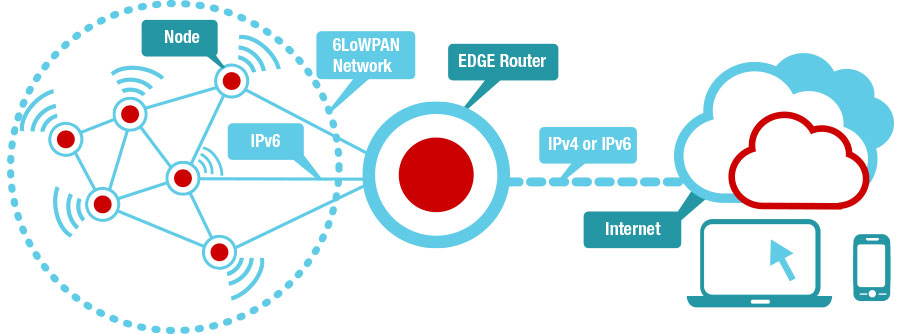THIS & THAT
A column by Jim Harrison
Now that IoT now being discussed ad nauseum, we should have a look at something that has a good possibility of being its main underpinning – 802.15.4 and 6LoWPAN networking.
The choices you have for wireless/wired connectivity technologies include Bluetooth (classic and v4.0, or Smart, or LE), Wi-Fi 802.11 (g, a/g, n, ac, ad, Wi-Fi Direct), NFC, GPS, and 802.15.4, ZigBee, RF4CE, and 6LoWPAN. For fairly low bit rate, possible fairly long distance, low cost connections 6LowPAN may have a leg-up.
If the IoT gets to be really big it will need low cost, low power wireless connectivity. It will certainly have wired connections, but to be “ubiquitous” it really must have a big wireless component. IEEE 802.15.4 is a standard which specifies the physical layer and media access control for low-rate wireless personal area networks (LR-WPANs) and is the basis for the ZigBee, ISA100.11a, WirelessHART, and MiWi specifications – and it is the basis for 6LowPAN. 802.15.4 is a MAC and PHY layer protocol (OSI layers 1 and 2). It is NOT the same thing as ZigBee – though people often talk of it that way. ZigBee is a Network Layer (OSI layer 3) protocol, which sits on top of 802.15.4.
IEEE 802.15.4 can operates on several bands –
– 2.4 GHz ISM band (Q-QPSK at 250 Kbits/s) 20 dBm, 100 mW
– 915 MHz (BPSK at 40 kb/s, Q-QPSK at 250 kb/s) >10 dBm
– 868 MHz (BPSK at 20 kb/s, Q-QPSK at 100 kb/s) 1 W (USA)
Both ZigBee and 6LoWPAN benefit from built-in AES128 encryption, which is part of the 802.15.4 standard. IC companies providing 802.15.4 transceivers or wireless enabled MCUs include Texas Instruments, Freescale, Analog Devices, Silicon Labs, Atmel, Microchip, and STMicro. Other companies offer wireless modules.
The ZigBee standard for low-power, low data rate, wireless communication between small devices and is controlled by the ZigBee Alliance . The standard is available for no charge for non-commercial purposes only. A paid membership in the ZigBee Alliance is required in order to produce products which use ZigBee networking.
6LoWPAN is a low-power wireless mesh network where every node has its own IPv6 address, allowing it to connect directly to the Internet using open standards. It has been around a long time, but is gaining more interest as of late. 6LoWPAN can connect a single sensor node with very low power and very small code and RAM space. It uses IP to communicate, so hooking up to the Internet is easy and it uses IPv6 so lots of addresses are available. It can use wireless or wired connections. The typical code size for a full-featured stack is 90 Kbytes for ZigBee and only 30 Kbytes for 6LoWPAN.
802.15.4 has a maximum transmit unit (MTU), or packet size, of 127 bytes, while IPv6 needs an MTU of 1,280 bytes. 6LoWPAN therefore uses a header compression algorithm to wedge IPv6 into 802.15.4. IP routing over 6LoWPAN links does not necessarily require additional header information at the 6LoWPAN layer. This cuts down on packet overhead and allows more room for the payload data.
A LoWPAN is the collection of 6LoWPAN nodes which share a common IPv6 address prefix (the first 64 bits of an IPv6 address), meaning that regardless of where a node is in a LoWPAN its IPv6 address remains the same. An Ad hoc LoWPAN is not connected to the Internet and operates without an infrastructure. A Simple LoWPAN is connected through one LoWPAN edge router to another IP network. An Extended LoWPAN encompasses the LoWPANs of multiple edge routers along with a backbone link interconnecting them. A broadcast PAN ID would be 0xffff.

Fig. 1: A system with simple IP router, no-application-layer gateway. The compressed IPv6 header needs an intermediary device to provide a conversion between 6LoWPAN and standard IP header. An EDGE router can be seen as this simplified “gateway”. This can be a standalone or an add-on system. Image from Texas Instruments.
Software for 6LoWPAN is available from a number of sources. Atmel has licensed Sensinode's 6LoWPAN software stack. Now ARM has purchased Sensinode, so this software is available with ARM’s mbed development platforms, including those from Atmel.
TI offers Contiki and Thingsquare Contiki software. Contiki-OS is an open source OS which integrates an Ipv6/6LoWPAN stack. All tools, including network simulator/emulator COOJA, are free and open source.
IBM’s has announced that it is teaming up with Spanish startup Libelium to offer an IoT starter kit that has Libelium’s Waspmote wireless sensor platform with IBM’s Mote Runner software and 6LoWPAN. Dust Networks products from Linear Technology are built on Eterna 802.15.4 SoC technology, and is based on 6LoWPAN and 802.15.4e standards.
Cisco Systems also has an investment in 6LoWPAN with its 2010 purchase of Arch Rock, for its smart grid applications. Platforms from Electric Imp, Ayla Networks, and ThingSquare, all of which offer modules and services to connect devices directly to the internet, are gaining ground, helping make the case for 6LoWPAN.
Advertisement
Learn more about Electronic Products Magazine





